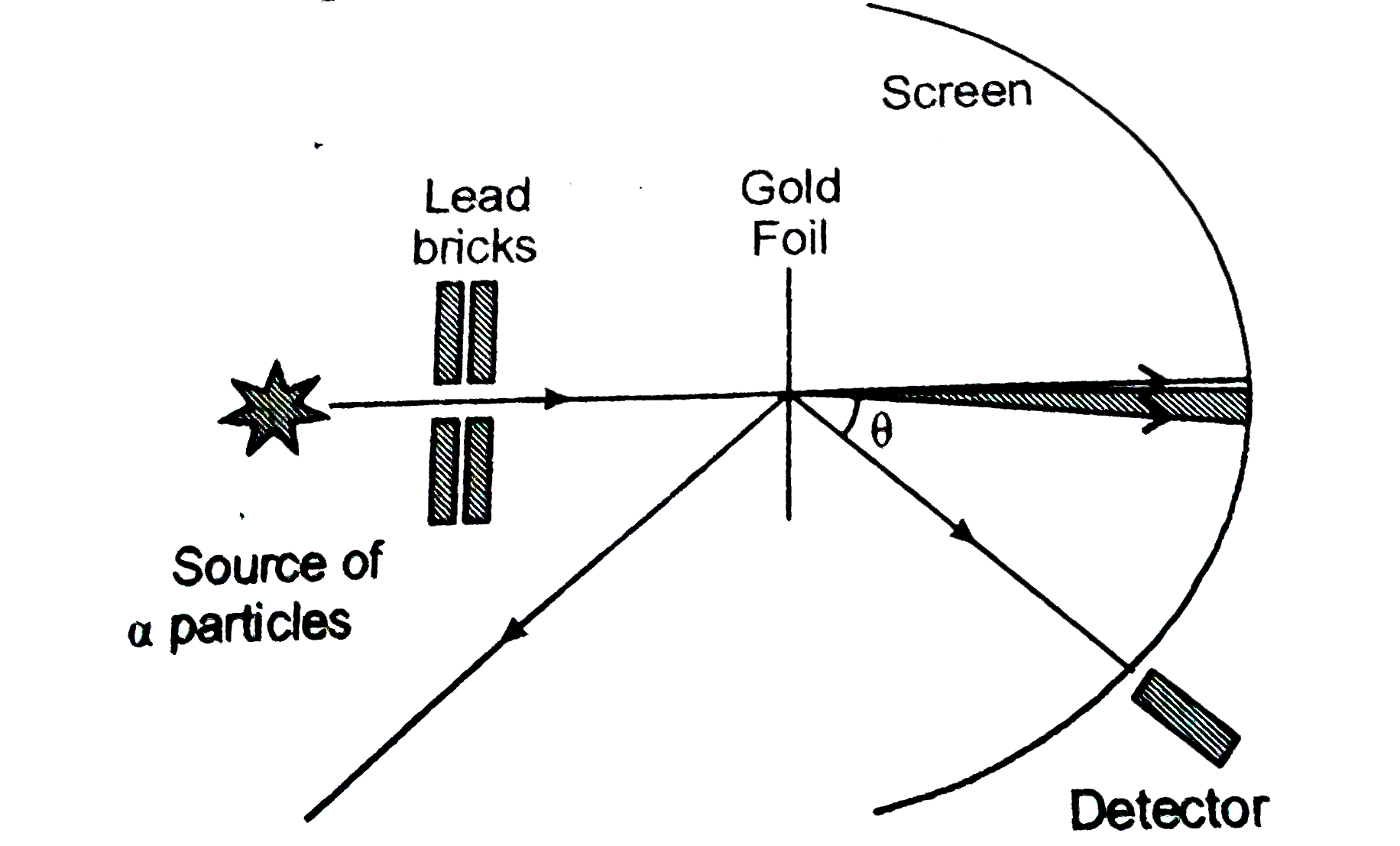With the help of a neat labelled diagram, describe the Geiger-Marsden experiment. What is mass defect ?
The photoelectric work function for a metal surface is 2:3eV. If the light of wavelength 6800Å is incident on the surface of metal, find threshold frequency and incident frequency. will there be an emission of photoelectron or not ?
[Velocity of light c=3×108m/s, Planck's constants, h=6.63×10−34Js]
Geiger-Marsden experiment : The setup of the Geiger- Marsden experiment is as shown below .

In this experiment,a narrow beam of α-particle from a radioactive soure was incident on a gold foil. The scattered α-particles were detected by the detector fixed on a rotating stand. The detector used had a zinc sulphide screen and a microscope.
The α-particles produced scintillations on the screen which could be observed through a microscope. This entire setup is enclosed in an evacuated chamber.
They observed the number of α-particles as a function of scattering angle. Now, the scattering angle is the deviation (θ) of α-particles from its original direction.
They observed that most α-particles passed undeviated and only a few (−0.14%) scattered by more than 1∘. Few were deflected slightly and only a few (1in 8000) deflected by more than 90∘. Some particles even bounced back with 18∘.
Mass defect : It is observed that the mass of a nucleus of smaller than the sum of the masses of the contituent nucleons in the free state. The difference between the actual mass of the nucleus and the sum of the massses of constituent nucleons is called mass defect.
The mass defect is
Δm=[Zmp+(A−Z)mn]−M
where Z is the atomic number (number of protons ), A is the mass number, (A-Z) is the number of neutrons, mp is the mass of the a proton, mn is the mass of a neutron and is the measured mass of a nucleus.
Given : ϕ0=2.3eV=2.3×1.6×10−19J=3.68×10−19J
λ=6800Å=6800×10−10mc=3×108m/s.
h=6.63×10−34Js
We know that the incident frequency is given as
v=cλ
∴v=3×1086800×10−10=4.41×1014
Now, if the incident frequency is greater than the threshold frequency , then photoelectrons will be emitted from the metal surface. The threshold frequency is given from work function as ltbr v0=ϕ0h
∴v0=3.68×10−196.63×10−34=5.55×1014Hz
Since v<v0, photoelectrons will not be emitted.
Topper's Solved these Questions
- FEBRUARY 2016BOOK - GURUKUL PUBLICATION - MAHARASHTRA PREVIOUS YEAR PAPERSCHAPTER - FEBRUARY 2016EXERCISE - SECTION-II
21 Videos
- FEBRUARY 2014BOOK - GURUKUL PUBLICATION - MAHARASHTRA PREVIOUS YEAR PAPERSCHAPTER - FEBRUARY 2014EXERCISE - SECTION-II
21 Videos
- FEBRUARY 2018BOOK - GURUKUL PUBLICATION - MAHARASHTRA PREVIOUS YEAR PAPERSCHAPTER - FEBRUARY 2018EXERCISE - SECTION-II
21 Videos
Similar Questions
Draw a neat and labelled energy level diagram and explain Balmer series and Bracket series of spectral lines for hydrogen atom.
The work function for a metal suface is 2.2 eV. If light of wavelength 5000 Å is incident on the surface of metal, find the threshold frequency and incident frequency. Will there be an emmission of photoelectrons or not ?
(c=3×108m/s,1eV=1.6×10−19J,h=6.63×10−34J.s.)
View SolutionPhotoelectric work function for a surface is 2.4 eV. Light of wavelength 6.8×10−7m shines on the surface. Find the frequency of incident light and also the threshold frequency. Will there be photoelectric emission or not ?
View Solution
Knowledge Check
The work function of a metal is 2.5 eV. Light of wavelength 3600 Å is incident on this metal surface. The velocity of emitted photoelectrons will be
A3.8×106m/sB5.2×104m/sC4×104m/sD6×105m/sThe photoelectric work function of a surface is 2.2 eV. The maximum kinetic energy of photoelectrons emitted when light of wavelength 6200 Å is incident on the surface, is
A0.4 eVB1.2 eVC1.6 eVDPhotoelectrons are not emitted.If the work function of a metal is 'ϕ' and the frequency of the incident light is 'v', there is no emission of photoelectron if
Av<ϕhBv=ϕhCv>ϕhDv≥ϕh
If the work function of a metal is 'ϕ' and the frequency of the incident light is 'v', there is no emission of photoelectron if
View SolutionThe work function of metal is 1eV. Light of wavelength 3000Å is incident on this metal surface . The velocity of emitted photo - electrons will be
View SolutionIf the photoelectric work function of a metal is 5 eV , the threshold frequency of the metal is
View SolutionA photon of frequency v is incident on a metal surface whose threshold frequency is v0. The kinetic energy of the emitted photoelectrons will be
View SolutionThe work function of a metal is 4 eV. What should be the wavelength of the incident radiation for the emission of photoelectrons of zero velocity ?
View Solution
